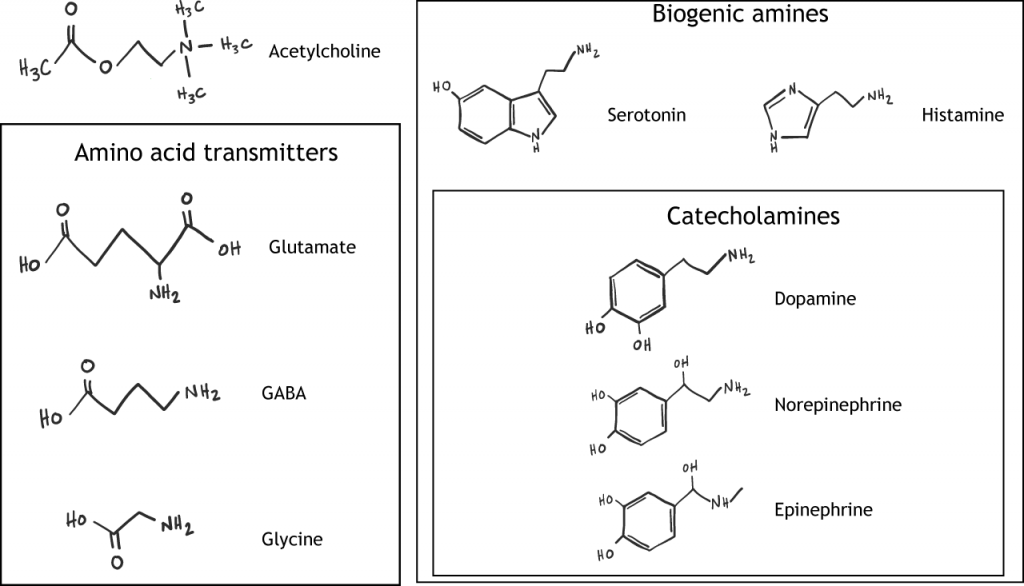14 Introduction to Small Molecule Neurotransmitters
Neurotransmitters are the substances that are released at chemical synapses, and they are the signaling molecules that allow neurons to communicate with one another. To date, scientists have identified more than 100 neurotransmitters.
A few criteria must be met for a molecule to be called a neurotransmitter. First, the neurotransmitter must be synthesized within the presynaptic neuron. Second, the neurotransmitter must be released by the presynaptic neuron in response to stimulation. Third, when a postsynaptic neuron is treated with the neurotransmitter by a researcher, the molecule must cause the same effect in the postsynaptic neuron as when it is released by a presynaptic neuron.
The next several chapters will cover a subset of neurotransmitter systems. For each neurotransmitter system, we will provide information on: the synthesis and storage of the neurotransmitter in the presynaptic cell; the receptors that the neurotransmitter binds to on the postsynaptic cell and the postsynaptic effects; and how neurotransmitter signaling is terminated.
Neurotransmitter Vesicles: Types of Vesicles
There are two main categories of neurotransmitters: small molecule neurotransmitters and peptide neurotransmitters (covered in Chapter 19). Synthesis and storage of these neurotransmitter groups differ. Small molecule neurotransmitters are synthesized and stored in the terminal for fast release. Neuropeptides are synthesized in the cell body and must be transported to the terminal, which can lead to slower release. Additionally, a neuron typically will synthesize and release only one type of small molecule neurotransmitter, but can synthesize and release more than one neuropeptide.
Molecules of neurotransmitters are often stored in synaptic vesicles before being released. Synaptic vesicles are tiny spheres of neurotransmitter enclosed by a phospholipid bilayer just like the cell membrane. These vesicles can be roughly characterized into two classes:
- Small vesicles. Small vesicles are responsible for storage of small molecule neurotransmitters. Given the size of neurotransmitters, we can estimate that thousands to tens of thousands of molecules of neurotransmitter can be stored in each vesicle. Small vesicles store many of the neurotransmitters we most often think of, including glutamate, GABA, dopamine, and norepinephrine. Small vesicles are almost always exclusively found in the axon terminals.
- Large dense-core vesicles. These vesicles are much larger than small vesicles. They store peptides such as dynorphin or enkephalin, which have chemical structures much larger than the small molecule neurotransmitters. Since these peptides are packaged into their vesicles near the nucleus, large dense-core vesicles can be found in the cell bodies and all along the axons in addition to the axon terminal.
Small Molecule Transmitters
Let’s first discuss the small molecule neurotransmitters. The small molecule neurotransmitters can be divided into two main groups: amino acid neurotransmitters and biogenic amines (also called monoamines). In addition to acting as neurotransmitters, the amino acids glutamate and glycine are used to synthesize proteins in all cell types throughout the body. GABA (Ɣ-Aminobutyric acid) is a metabolite of glutamate, but is not used in protein synthesis in the body. The biogenic amines include serotonin, histamine, and the subgroup catecholamines: dopamine, norepinephrine, and epinephrine. Acetylcholine does not fit into either division but is still considered a small molecule neurotransmitter.
Most small molecule neurotransmitters are synthesized by enzymes that are located in the cytoplasm (the exception is norepinephrine, see Chapter 17). This means that small molecule neurotransmitters can be synthesized and packaged for storage in the presynaptic terminal using enzymes present in the terminal.

The effect of the neurotransmitter is dependent on the properties of the postsynaptic receptor
In the last chapter, the mechanisms of ionotropic and metabotropic (GPCRs) were covered. In the chapters that follow, we will focus on a subset of neurotransmitter systems and identify the different neurotransmitter receptors and their function.
Key Takeaways
- Small molecules neurotransmitters are synthesized and packaged into vesicles in the presynaptic terminal
- There are different types of vesicles that hold small molecule neurotransmitters versus neuropeptide neurotransmitters
Test Yourself
Attributions
Portions of this chapter were remixed and revised from the following sources:
- Foundations of Neuroscience by Casey Henley. The original work is licensed under a Creative Commons Attribution-NonCommercial-ShareAlike 4.0 International License
- Open Neuroscience Initiative by Austin Lim. The original work is licensed under a Creative Commons Attribution-NonCommercial 4.0 International License.

